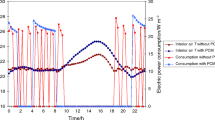Abstract
The number of data centres (DC) in recent years is growing rapidly, and with that, the share in total consumption of electricity is growing too. A significant amount of electricity is transformed into heat energy which increases the optimal temperature in DC for component operation. This heat needs to be removed and usually, it doesn’t have any further application. Today it is recognized that waste heat can be integrated into district heating (DH) and by using it reduce the usage of conventional heat fuels. Integration of waste heat is possible in three ways: with a heat exchanger (HEX), with a booster heat pump, or with the combination of the HEX and heat pump. In this paper, a combination of HP and HEX was used. Although those utilizations are examined and implemented, there is a lack of research on the optimization of the integration of waste heat into the district heating network (DHN). To perform optimization, a thermodynamic model of the DC and a pinch analysis model were developed. In this study, a method for evaluating the economic feasibility of DC waste heat integration into DH systems is proposed. The most suitable integration technology of waste heat into DH systems by using the hourly merit order of waste heat utilization technologies based on pinch analysis is found. The connection pipe between DC and DHN is optimized, and the ideal diameter is determined considering different temperature regimes of the network: low-temperature, ultralow temperature, and neutral temperature networks. The methodology was tested using a case study of a DC in the City of Zagreb.





















Similar content being viewed by others
References
Aromada SA, Eldrup NH, Normann F, Øi LE (2020) Techno-economic assessment of different heat exchangers for CO2 capture. Energies 13(23):6315. https://doi.org/10.3390/EN13236315
Bertelsen N, Mathiesen BV (2020) EU-28 residential heat supply and consumption: historical development and status. Energies (basel). https://doi.org/10.3390/en13081894
Best I, Orozaliev J, Vajen K (2018) Economic comparison of low-temperature and ultra-low-temperature district heating for new building developments with low heat demand densities in Germany. Int J Sustain Energy Plan Manag 16:45–60. https://doi.org/10.5278/IJSEPM.2018.16.4
Danish Energy Agency (2016) Technology data-energy plants for electricity and district heating generation. Copenhagen. [Online]. Available: http://www.ens.dk/teknologikatalog
Davies GF, Maidment GG, Tozer RM (2016) Using data centres for combined heating and cooling: an investigation for London. Appl Therm Eng 94:296–304. https://doi.org/10.1016/J.APPLTHERMALENG.2015.09.111
Deymi-Dashtebayaz M, Valipour-Namanlo S (2019) Thermoeconomic and environmental feasibility of waste heat recovery of a data center using air source heat pump. J Clean Prod 219:117–126. https://doi.org/10.1016/J.JCLEPRO.2019.02.061
Dorotić H, Čuljak K, Miškić J, Pukšec T, Duić N (2022) Technical and economic assessment of supermarket and power substation waste heat integration into existing district heating systems. Energies 15(5):1666. https://doi.org/10.3390/EN15051666
Ebrahimi K, Jones GF, Fleischer AS (2014) A review of data center cooling technology, operating conditions and the corresponding low-grade waste heat recovery opportunities. Renew Sustain Energy Rev 31:622–638. https://doi.org/10.1016/j.rser.2013.12.007
Energija u Hrvatskoj (2020) L energy in Croatia 2020 predgovor l foreword energy in Croatia 2020
European Commision and Joint Research Centre (2017) JRC photovoltaic geographical information system (PVGIS). https://re.jrc.ec.europa.eu/pvg_tools/en/. Accessed 05 May 2022
Fu L, Li Y, Wu Y, Wang X, Jiang Y (2021) Low carbon district heating in China in 2025: a district heating mode with low grade waste heat as heat source. Energy 230:120765. https://doi.org/10.1016/J.ENERGY.2021.120765
Fuchs H et al (2020) Comparing datasets of volume servers to illuminate their energy use in data centers. Energy Effic 13(3):379–392. https://doi.org/10.1007/s12053-019-09809-8
Ghatikar G et al (2009) Demand response and open automated demand response opportunities for data centers. Berkeley, CA (United States). https://doi.org/10.2172/981725
Home—Eurostat https://ec.europa.eu/eurostat. Accessed 05 May 2022
Huang P et al (2020) A review of data centers as prosumers in district energy systems: renewable energy integration and waste heat reuse for district heating. Appl Energy. https://doi.org/10.1016/j.apenergy.2019.114109
Jensen JK, Ommen T, Reinholdt L, Markussen WB, Elmegaard B (2018) Heat pump COP, part 2: generalized COP estimation of heat pump processes. Refrig Sci Technol 2018:1255–1264. https://doi.org/10.18462/iir.gl.2018.1386
Lennermo G, Lauenburg P, Werner S (2019) Control of decentralised solar district heating. Sol Energy 179:307–315. https://doi.org/10.1016/J.SOLENER.2018.12.080
Li J, Jurasz J, Li H, Tao WQ, Duan Y, Yan J (2020) A new indicator for a fair comparison on the energy performance of data centers. Appl Energy 276:115497. https://doi.org/10.1016/J.APENERGY.2020.115497
Li J, Yang Z, Li H, Hu S, Duan Y, Yan J (2021) Optimal schemes and benefits of recovering waste heat from data center for district heating by CO2 transcritical heat pumps. Energy Convers Manag. https://doi.org/10.1016/j.enconman.2021.114591
Oró E, Taddeo P, Salom J (2019) Waste heat recovery from urban air cooled data centres to increase energy efficiency of district heating networks. Sustain Cities Soc 45:522–542. https://doi.org/10.1016/J.SCS.2018.12.012
Rasmussen N (2011) Guidelines for specification of data center power density white paper | Schneider Electric. Schneider Electric Science Center. https://www.se.com/id/en/download/document/SPD_NRAN-69ANM9_EN/. Accessed 14 Dec 2021
Salom J, Sisó L, Sansigre M (2014) Cost-effective renewable cooling on green data centres. Barcelona
Technology Data for Generation of Electricity and District Heating | Energistyrelsen https://ens.dk/en/our-services/projections-and-models/technology-data/technology-data-generation-electricity-and. Accessed 05 May 2022
Thomaßen G, Kavvadias K, Jiménez Navarro JP (2021) The decarbonisation of the EU heating sector through electrification: a parametric analysis. Energy Policy 148:111929. https://doi.org/10.1016/J.ENPOL.2020.111929
TRANE (2010) Air-cooled series RTM helical-rotary liquid chiller—model RTAC 120 to 400 (400 to 1500 kW–50 Hz) built for the industrial and commercial markets. Brussels
Wahlroos M, Pärssinen M, Manner J, Syri S (2017) Utilizing data center waste heat in district heating—Impacts on energy efficiency and prospects for low-temperature district heating networks. Energy 140:1228–1238. https://doi.org/10.1016/j.energy.2017.08.078
Wahlroos M, Pärssinen M, Rinne S, Syri S, Manner J (2018) Future views on waste heat utilization—Case of data centers in Northern Europe. Renew Sustain Energy Rev 82:1749–1764. https://doi.org/10.1016/j.rser.2017.10.058
Wheatcroft E, Wynn H, Lygnerud K, Bonvicini G, Leonte D (2020) The role of low temperature waste heat recovery in achieving 2050 goals: a policy positioning paper. Energies (basel). https://doi.org/10.3390/en13082107
Acknowledgements
We would like to express our gratitude to the consortium of the REWARDHeat (Renewable and Waste Heat Recovery for Competitive District Heating and Cooling Networks) Horizon2020 project, Grant Agreement no. 857811. Also, we would like to express our gratitude to the Croatian Science Foundation.
Author information
Authors and Affiliations
Corresponding author
Additional information
Publisher's Note
Springer Nature remains neutral with regard to jurisdictional claims in published maps and institutional affiliations.
Rights and permissions
Springer Nature or its licensor (e.g. a society or other partner) holds exclusive rights to this article under a publishing agreement with the author(s) or other rightsholder(s); author self-archiving of the accepted manuscript version of this article is solely governed by the terms of such publishing agreement and applicable law.
About this article
Cite this article
Miškić, J., Dorotić, H., Pukšec, T. et al. Optimization of data centre waste heat integration into the low-temperature district heating networks. Optim Eng 25, 63–91 (2024). https://doi.org/10.1007/s11081-023-09837-5
Received:
Revised:
Accepted:
Published:
Issue Date:
DOI: https://doi.org/10.1007/s11081-023-09837-5




